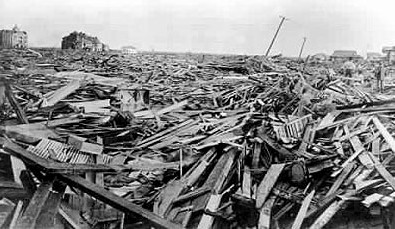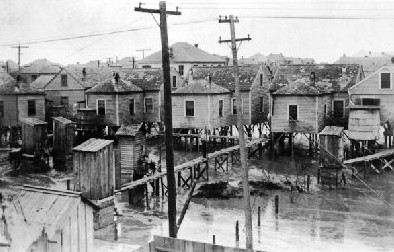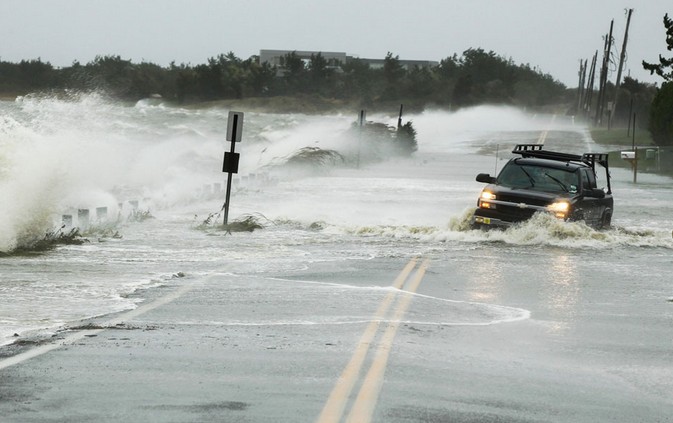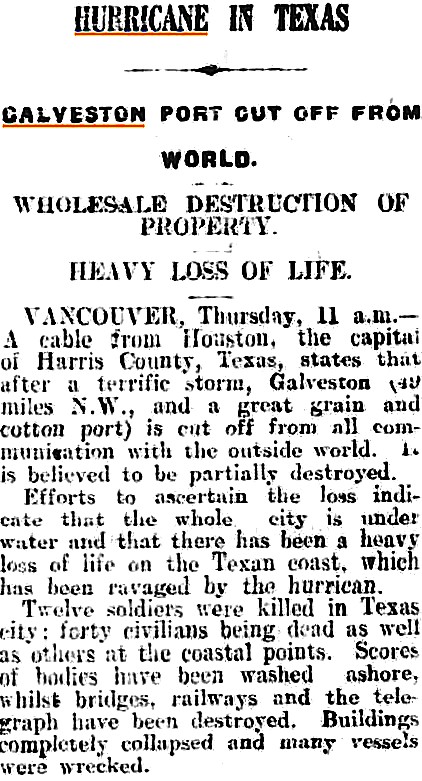It was the best of engineers. It was the worst of scientists.
In the year 1900, Galveston Texas was hit by a 145 MPH hurricane and storm surge which wiped out most of the city and killed 10,000 people.
How did they deal with it?
The city was flooded repeatedly down through the 19th century. In 1886 a commission talked about building a wall against the sea, but they rejected the idea. It would cost too much. Now Galveston had seen just how bad a hurricane could be. Citizens knew they’d have to either give up their city or protect it.
So by a ratio of 150 to 1 the people who could vote decided to undertake a wild engineering scheme. They would build a great dam, a Sea Wall along the south Gulf coast. It’d be 17 feet high and 3 miles long with a skirt of protective granite rip-rap. But the Sea Wall was a piece of cake compared to what followed. Next they raised the whole city. And this was the major city in Texas.
They slanted the ground so water that got over the Sea Wall could run off toward the bay on the north. That meant raising the ground almost to the lip of the Wall. Then they sloped it downward to eight feet above sea level on the north.
To do that, they cut a canal into the city and began pumping in a slurry of sand and salt water. The water ran off and left sand behind. Homeowners had to lift their houses up on stilts so the slurry could fill in under them.
It took 300 jacks to lift the big brick Moody mansion. It took 700 jacks to lift St. Patrick’s church. Of course there was a component of brutality in all that. Some homeowners couldn’t afford the raising. Some had to sacrifice the bottom floor of their houses. Some had to abandon their homes entirely.
The work went on in sections for seven years. In 1915 the new city they’d built suffered its first test. A storm every bit as bad as the 1900 hurricane hit Galveston and caused only eight deaths. Since then they’ve extended the Wall and filled in more land. No one at all died in hurricanes Carla and Alicia.
And, today, the very presence of Galveston is one of the great joys of living in Texas.
In the year 2011, Staten Island and Long Island were hit by a storm surge from a tropical storm with 60 MPH winds.
How did they deal with it? The mayor of New York published a special edition of his newspaper demanding that we reduce CO2 emissions. This was based on the testimony of the world’s leading climate scientists.
In 1915, Galveston was hit by another major hurricane – and suffered only eight dead.
The North Western Advocate and the Emu Bay Times Friday 20 August 1915
20 Aug 1915 – HURRICANE IN TEXAS GALVESTON PORT CUT OFF FROM W…
Galveston survived because they listened to practical, smart engineers. Had Galveston instead listened to scientists like James Hansen and Michael Mann, they wouldn’t be here today. Hurricane Ike in 2008 would have destroyed the city without the engineering done over 100 years ago.
h/t to David Appell, for reminding us just how clueless the climate science community is.






Today it would take Galvaston 20 years to secure the permits to do the work. NYC is considering a barrier but they don’t anticipate any construction to start for more than a decade because of all the reviews and approvals needed. At least NYC can legitimately claim a benefit from climate legislation such as cap and trade. It won’t change the weather but it would make the Wall Street types richer.
See, David is good for something. Although I must admit it did take years for us to figure out what. 😉
What a wonderfully interesting and informative article! The best thing I’ve read all week.
I agree with Dave B — thank you for posting this
Ditto … great article!
I used to go to Galveston in the past. Now that I’m older and a lot wiser, I find this very remarkable. If we ask for that these days, it’d never happen.
I met my wife in Galveston.
Is her nickname Stormy ? 🙂
Really? Cool. I met mine about 190 miles north-northeast of Galveston 12 years ago at a college.
An excellant comparison Steven , I like your thinking . This is one of my top sites to go to in the morning as it always leaves me charged for the daily battle with the lies of the alarmists . Keep the information coming , please .
Glen Campbell (Galveston):
http://www.youtube.com/watch?v=xsHUgpSxMoI
Yeah but in Galveston it was “roll up our sleeves time” while on the Eastern Seaboard, it was “where the help at?” A whole different mentality of entitlement exists now in the US. This seems to be the enduring message of Katrina and Sandy.
Building on a seashore or within its flood banks has a guaranteed rate of return: it will eventually have to be rebuilt. In other words, the reason why we see the strata under Istanbul or Rome or Keos is because 1) Mother Nature has been in control for a long time and 2) Public Works are the best employment for a certain subset of any given populace. Build on the water and you create jobs, improvements and a movement simple folk can get behind, plus any number of side-projects (AGW for one) that can be funded. That’s a 5,000-year recipe for success.
I kept in contact with a friend that is a claim insurance adjuster in NJ and he said that people there seems to really rely on government to do something. Just a different mindset than we’d used to seeing in Texas.
Thanks Mr. Appell for inspiring Steven for such a good article. Amazing how good honest scientific knowledge was put to good work by talented, practical, engineering skill and the consent and patience of the local population.
David please could you inspire Steven again?
Great post Steven. It’s sad watching a nation of brave independent people become lazy, and stupid enough to believe whatever garbage is being sold by the federal government.
Steven,
Thanks for the inspirational Galveston story – I had no idea of that history.
Steve, may I repost this?
Of course!
As a mining engineer, I’m impressed with how Galveston solved such a major problem 100 years ago. In Kalgoorlie, Western Australia, there was no fresh water 110 years ago at the worlds biggest gold rush, for 30,000 people. An engineer, CY O’Connor, built a dam in Perth and a 650 km steel 30 inch diam pipeline with pump stations to bring fresh water to the city. One of the biggest engineering feats of the time. It’s still doing the job 110 years later, albeit with new electric, rather than steam driven pumps, for over 50,000 in the gold fields of WA. If they tried to do it today, the howls of objection from so many vested interests would stop the project dead. Yet they put up massive wind farms here without detailed EPA studies. Hypocrites.
Nevertheless a whole bunch of people decided to build on higher ground with the result that Houston is now a much larger city than Galveston.
Galveston is a tiny island, which is completely built out.
How would they deal with it today?
Much like this, I expect – before they fire up the FEMA camps:
“Owing to the lack of remunerative employment and the stress of the winter weather, it is computed that there are quite 50,000 destitute and starving persons in the City of
Chicago. Much excitement prevails among the poorer classes, and at the meetings of the unemployed incendiary and threatening language is being continually used. The Mayor of the city is appealing to the wealthy citizens for relief funds. He urges that effective measures are needed in order to arrest riots.”
http://trove.nla.gov.au/ndp/del/article/54473185
~27 Jan 1897
Hey Steven, something to think about . It a little over one month this nation will have gone 100 years with having the cream of it’s efforts stolen by those who through no physical effort of their own take money right off the top of the American pie . It is called the frederal reserve . For 100 hundred years the banks have been legally stealing a living from everyone else by having a law that allows them to charge us interest on our own money the instant it is printed . I think 100 years is way more than enough time for people to figure this scam out yet it is still continueing to happen . The bankers and their crooked cronies think of themselves as the elite who deserve to have the first fruits of our efforts and we are letting them do it .